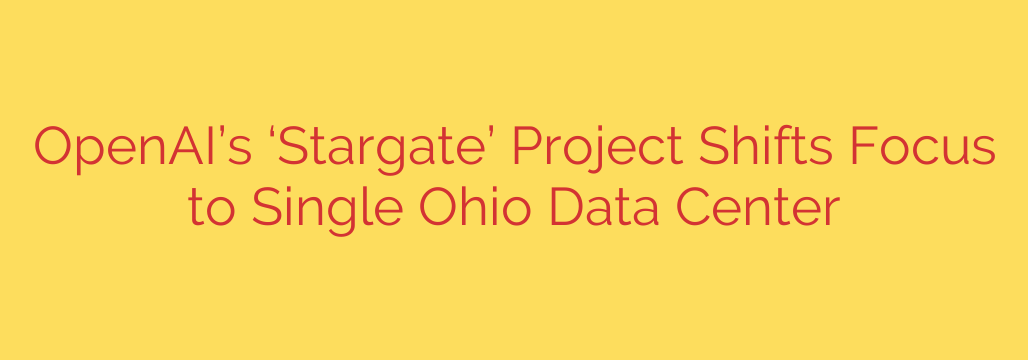
Inside Stargate: Why OpenAI and Microsoft Are Betting Billions on a Single AI Supercomputer
The race to build the future of artificial intelligence is demanding more than just brilliant code—it requires a staggering amount of physical infrastructure. In a significant strategic move, OpenAI and Microsoft are channeling their resources into an audacious project known as “Stargate,” an AI supercomputer poised to redefine the limits of computational power.
Recent developments indicate a major shift in this multi-billion-dollar initiative. Instead of distributing the project across multiple locations, the focus has now narrowed to a single, colossal data center campus, with a site in Ohio emerging as the prime candidate. This consolidation represents a monumental bet on centralized computing power to fuel the next generation of AI models.
The Grand Vision of Stargate
Stargate is not just another data center. It’s envisioned as the engine that will power artificial intelligence far beyond today’s capabilities, potentially leading the way toward Artificial General Intelligence (AGI). To achieve this, it requires an unprecedented level of investment and energy.
The project is structured in five phases, with Stargate being the fifth and most ambitious. While earlier phases are already underway, Stargate is the long-term goal, designed to house millions of specialized AI accelerator chips and consume enormous amounts of power.
Key aspects of this initiative include:
- A Multi-Billion Dollar Investment: This project represents a massive financial commitment, primarily funded by Microsoft, highlighting the depth of its partnership with OpenAI. The scale of the investment underscores the high stakes involved in leading the AI revolution.
- Unprecedented Power Requirements: The Stargate supercomputer is expected to consume several gigawatts of power, enough to power millions of homes. This immense energy need is a primary driver behind the choice of location and the consolidated design.
- A Foundation for Future AI: The infrastructure being built is not for running current models like GPT-4. Instead, Stargate is designed to train and operate AI systems that are orders of magnitude more complex and capable than anything that exists today.
The Strategic Shift to a Single, Massive Campus
Originally, the plan for Stargate involved a more distributed approach. However, the strategy has evolved to favor a single, hyper-scale location. This change reflects the immense logistical and technical challenges of building such a powerful system.
Consolidating resources into a single, massive facility offers several key advantages. It simplifies the complex process of securing land, managing construction, and, most critically, ensuring access to a stable and immense power supply. Building and interconnecting a system of this magnitude is far more efficient when all components are in one place.
Ohio, and specifically areas with access to robust power grids and available land, has become a hotspot for data center development. By focusing on a single campus, OpenAI and Microsoft can create a dedicated ecosystem built for one purpose: to house the world’s most powerful AI supercomputer.
What This Means for the Future of AI
This strategic consolidation is more than just a logistical decision; it signals a new era in AI development.
Centralization is Key: The future of cutting-edge AI may rely on centralized, purpose-built “AI factories” rather than decentralized cloud infrastructure. The sheer power and cooling demands of next-generation models make hyper-scale, dedicated facilities a necessity.
The Energy Challenge is Real: The gigawatt-level power consumption of Stargate highlights one of the biggest hurdles for the future of AI. Securing sustainable and reliable energy sources will be a defining challenge for any organization hoping to compete at the highest level.
The AI Race Intensifies: This project solidifies the deep technological and financial partnership between OpenAI and Microsoft, creating a formidable force in the AI landscape. It raises the barrier to entry significantly, as few companies can match the capital investment required to build infrastructure on this scale.
In conclusion, the Stargate project’s focus on a single, massive data center campus is a clear indicator of the direction AI infrastructure is heading. It’s a bold, incredibly expensive, and power-hungry bet that demonstrates an unwavering commitment to pushing the boundaries of what artificial intelligence can achieve. The success of this venture could very well determine who leads the next decade of technological innovation.
Source: https://datacentrereview.com/2025/07/openai-softbank-stargate-project-stalls-pivots-to-single-ohio-data-centre/








